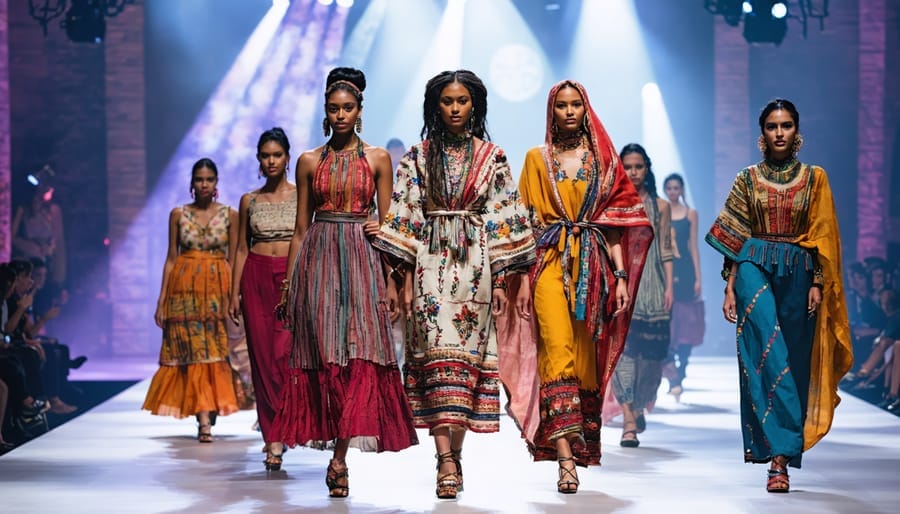
Fabrics have long been an integral part of human history, representing the rich cultural heritage, traditions, and artistry of different regions. From the intricate handwoven textiles of Africa to the luxurious silks of Asia and the colorful embroidery of Latin America, cultural and traditional fabrics tell stories of identity, craftsmanship, and generations of skill.
In this article, we explore some of the world’s most iconic cultural fabrics, their origins, and their significance in today’s global textile industry.
1. African Fabrics: Bold Patterns & Symbolism
Kente (Ghana)
Kente cloth, originally worn by Ashanti and Ewe royalty, is known for its vibrant colors and intricate geometric patterns. Each color and design has a meaning, with gold symbolizing wealth, blue representing peace, and green signifying renewal. Today, Kente is worn for special occasions and has gained global recognition in fashion.
Ankara (West Africa)
Ankara fabric, also called African wax print, is known for its bright, bold patterns. Though originally inspired by Indonesian batik, it has been embraced across Africa as a symbol of cultural identity. Ankara is widely used in clothing, accessories, and home décor.
Mud Cloth (Bogolanfini) – Mali
Mud cloth is a hand-dyed cotton fabric created using fermented mud and plant dyes. Traditionally made by the Bamana people, each pattern carries cultural significance, representing historical events, social status, and proverbs.
2. Asian Fabrics: Elegance & Tradition
Silk (China & India)
Silk has been one of the most valuable fabrics in history, with China and India being leading producers for centuries. Chinese silk, often embroidered with intricate motifs, played a key role in the Silk Road trade. Indian silk, including Banarasi and Kanchipuram varieties, is renowned for its luxurious feel and gold-thread embellishments.
Kimono Fabrics (Japan)
Japanese kimono fabrics, such as chirimen (silk crepe) and kasuri (ikat-dyed cotton), showcase traditional dyeing and weaving techniques. Kimono patterns often depict nature, seasons, and cultural symbols.
Batik (Indonesia & Malaysia)
Batik is a fabric art form where wax is applied to cloth before dyeing to create intricate patterns. Indonesian batik is recognized as a UNESCO Intangible Cultural Heritage, with motifs reflecting local folklore, nature, and philosophy.
3. Middle Eastern & South Asian Fabrics: Luxury & Craftsmanship
Pashmina (Kashmir, India & Nepal)
Pashmina, often referred to as “cashmere,” is a fine wool fabric handwoven in the Himalayan regions of India and Nepal. Known for its softness and warmth, authentic Pashmina shawls are highly valued worldwide.
Zari & Brocade (India & Persia)
Zari is a weaving technique that incorporates metallic threads (gold or silver) into fabric, commonly seen in brocade textiles. Indian Banarasi brocade and Persian brocades are known for their luxurious appeal, used in bridal wear and royal garments.
Abaya & Thobe Fabrics (Middle East)
Middle Eastern traditional attire, including the abaya and thobe, is often made from high-quality fabrics like silk, chiffon, and crepe, sometimes adorned with embroidery and embellishments reflecting cultural influences.
4. European Heritage Fabrics: Classic & Timeless
Scottish Tartan (Scotland, UK)
Tartan, a patterned wool fabric, is deeply rooted in Scottish heritage. Each tartan design represents a specific clan or region, and it remains a symbol of Scottish identity today.
Lace (France & Italy)
French and Italian lace, such as Chantilly lace (France) and Venetian lace (Italy), have been associated with luxury and elegance for centuries. These delicate fabrics are often used in wedding dresses and haute couture fashion.
Linen (Ireland & Belgium)
Irish linen is globally renowned for its high quality, made from flax fibers and prized for its durability and breathability. Belgian linen is also highly valued in home textiles and apparel.
5. Latin American & Indigenous Textiles: Colorful & Handwoven
Peruvian Alpaca Wool (Peru)
Peru is famous for its alpaca wool textiles, known for being soft, warm, and sustainable. Indigenous communities use traditional looms to create colorful ponchos, scarves, and blankets.
Otomi Embroidery (Mexico)
Otomi embroidery, originating from the indigenous Otomi people of Mexico, features vibrant, hand-stitched patterns depicting animals, flowers, and nature. These textiles are used in clothing and home décor.
Panama’s Mola Fabric (Guna People)
Mola is a reverse appliqué textile art created by the Guna indigenous people of Panama. It involves layering fabrics and cutting intricate designs, often featuring animals and abstract shapes.
The Modern Influence of Traditional Fabrics
Traditional textiles are no longer confined to their regions of origin—they have influenced contemporary fashion, interior design, and sustainable textile movements worldwide. Many designers blend cultural fabrics with modern styles, preserving heritage while embracing innovation.
Ways Cultural Fabrics Are Used Today:
- Sustainable Fashion: Many cultural textiles are handmade and eco-friendly.
- High-Fashion & Runway Trends: Global designers incorporate traditional fabrics into haute couture.
- Home Decor: Handwoven and embroidered fabrics are popular in upholstery, rugs, and curtains.
- Ethical Trade: Many artisans rely on fair-trade markets to sustain their craft and pass down traditions.
Conclusion
Cultural and traditional fabrics are a testament to the diversity and artistry of global textile heritage. Whether you’re looking for handwoven African textiles, luxurious Asian silks, or intricate European laces, these fabrics carry centuries of history and craftsmanship.
At Wes Fabrics, we celebrate the beauty of cultural fabrics and connect global buyers with authentic, high-quality textiles. Explore our marketplace to discover the world’s finest traditional fabrics today!


